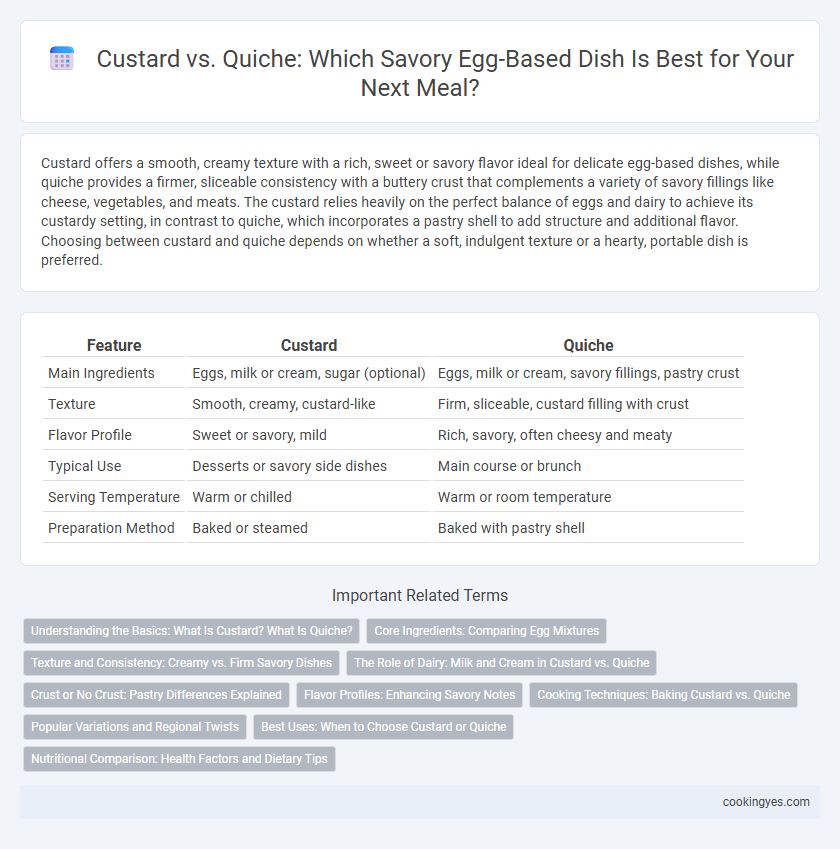Custard offers a smooth, creamy texture with a rich, sweet or savory flavor ideal for delicate egg-based dishes, while quiche provides a firmer, sliceable consistency with a buttery crust that complements a variety of savory fillings like cheese, vegetables, and meats. The custard relies heavily on the perfect balance of eggs and dairy to achieve its custardy setting, in contrast to quiche, which incorporates a pastry shell to add structure and additional flavor. Choosing between custard and quiche depends on whether a soft, indulgent texture or a hearty, portable dish is preferred.
Table of Comparison
| Feature | Custard | Quiche |
|---|---|---|
| Main Ingredients | Eggs, milk or cream, sugar (optional) | Eggs, milk or cream, savory fillings, pastry crust |
| Texture | Smooth, creamy, custard-like | Firm, sliceable, custard filling with crust |
| Flavor Profile | Sweet or savory, mild | Rich, savory, often cheesy and meaty |
| Typical Use | Desserts or savory side dishes | Main course or brunch |
| Serving Temperature | Warm or chilled | Warm or room temperature |
| Preparation Method | Baked or steamed | Baked with pastry shell |
Understanding the Basics: What Is Custard? What Is Quiche?
Custard is a smooth, creamy mixture made from eggs, milk or cream, and often sugar, thickened by gentle cooking, typically used in both sweet and savory dishes. Quiche is a savory pie consisting of a pastry crust filled with a custard mixture combined with ingredients like cheese, vegetables, and meats, baked until set. Understanding that custard serves as the foundational egg mixture, while quiche incorporates this custard into a structured, flavorful crust, highlights their distinct roles in savory egg-based cuisine.
Core Ingredients: Comparing Egg Mixtures
Custard for savory dishes typically features a smooth mixture of eggs, cream or milk, and seasoning, creating a silky texture when baked. Quiche combines the custard base with added ingredients like cheese, vegetables, and meats, baked within a pastry crust for structure and contrast. The core difference lies in custard's pure egg-cream blend versus quiche's heterogeneous filling and crust integration.
Texture and Consistency: Creamy vs. Firm Savory Dishes
Custard offers a smooth, velvety texture due to its higher cream and egg ratio, resulting in a creamy consistency that melts in the mouth. Quiche, baked with a pastry crust and a firmer egg mixture, presents a more structured, sliceable texture with a slightly dense and custardy interior. Understanding these differences helps in selecting the ideal savory egg dish based on desired creaminess versus firmness in texture.
The Role of Dairy: Milk and Cream in Custard vs. Quiche
Milk and cream play a crucial role in defining the texture and richness of savory egg-based dishes, with custard relying heavily on dairy to create a smooth, silky consistency. In custard, the higher ratio of cream or whole milk results in a custard that is dense yet tender, ideal for delicate mouthfeel, while quiche incorporates less dairy, balancing eggs and cream to maintain a firmer, sliceable structure. The fat content in cream enhances flavor and moisture in both, but quiche's incorporation of cheese and savory fillings shifts the dairy's role from purely textural to also flavor-enhancing.
Crust or No Crust: Pastry Differences Explained
Custard and quiche both highlight the versatility of savory egg-based dishes, with crust presence as a key differentiator. Quiche traditionally features a flaky pastry crust, providing a buttery, textured base that balances the creamy, egg custard filling enriched with cheese, vegetables, or meats. In contrast, crustless custards emphasize a smooth, dense consistency, allowing the egg mixture's flavor to stand out without the added richness or structure of pastry, ideal for lighter or gluten-free servings.
Flavor Profiles: Enhancing Savory Notes
Custard offers a smooth, creamy texture with subtle sweetness that balances the richness of savory ingredients, while quiche delivers a robust, flaky crust paired with a rich, egg-based filling infused with cheese, herbs, and vegetables for enhanced depth. The custard's delicate flavor allows for versatile seasoning, highlighting savory spices such as nutmeg and black pepper to elevate the taste profile. Quiche emphasizes a harmonious blend of textures and boldness, often incorporating sharp cheeses like Gruyere and aromatic herbs like thyme to intensify the savory experience.
Cooking Techniques: Baking Custard vs. Quiche
Baking custard requires gentle heat and slow cooking to achieve a smooth, creamy texture without curdling, often using a water bath to regulate temperature. Quiche baking involves a higher oven temperature that crisps the pastry crust while ensuring the egg mixture sets firmly with added fillings like cheese, vegetables, or meats. Precise temperature control and timing distinguish the delicate custard from the robust, savory quiche.
Popular Variations and Regional Twists
Custard and quiche each showcase unique savory egg-based variations, with custard often enriched by ingredients like cheese, herbs, or seafood in French cuisine. Quiche, particularly the classic Quiche Lorraine from Lorraine, France, features a rich custard filling with bacon and Swiss cheese, while regional twists include German Zwiebelkuchen with onions or Italian quiche-like tarts incorporating Mediterranean vegetables. Popular variations emphasize texture differences: silky, smooth custards contrast with quiche's firm, flaky crust combined with a creamy egg mixture.
Best Uses: When to Choose Custard or Quiche
Custard suits creamy, smooth textures ideal for desserts or delicate savory dishes that emphasize richness without heavy fillings. Quiche excels for robust, savory meals incorporating vegetables, meats, and cheeses, perfect for brunch or hearty lunches requiring a structured, sliceable dish. Choose custard when seeking a silky, custardy consistency and quiche when a balanced blend of eggs and toppings enhances flavor complexity.
Nutritional Comparison: Health Factors and Dietary Tips
Custard typically contains higher sugar and fat levels due to added cream and sweeteners, making it richer but less suitable for low-calorie diets. Quiche incorporates eggs with vegetables and cheese, offering more protein, fiber, and essential nutrients, benefiting those seeking balanced savory meals. Choosing whole grain crusts and reduced-fat cheese can enhance quiche's nutritional profile for heart-healthy diets.
Custard vs Quiche for Savory Egg-Based Dishes Infographic

 cookingyes.com
cookingyes.com